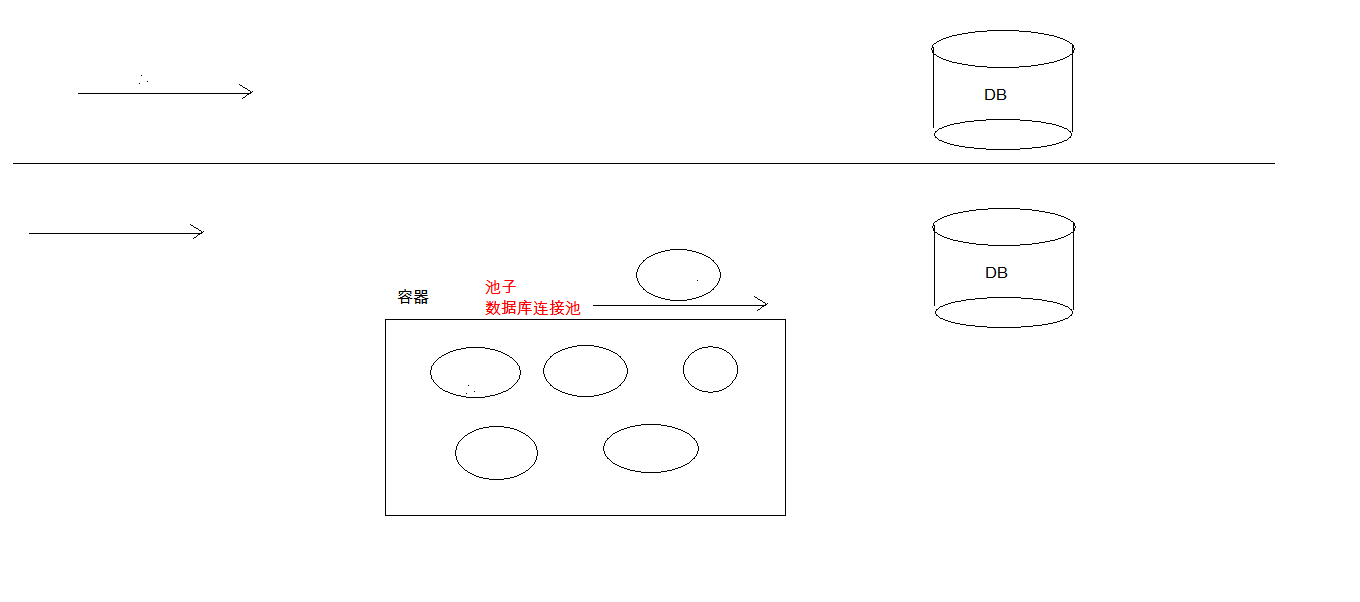数据库连接池
概念:其实就是一个容器 (集合),存放数据库连接的容器。
当系统初始化好后,容器被创建,容器中会申请一些连接对象,当用户来访问数据库时,从容器中获取连接对象,用户访问完之后,会将连接对象归还给容器。
好处
- 节约资源
- 用户访问高效
实现
标准接口:DataSource javax.sql 包下的
方法:
- 获取连接:
getConnection() - 归还连接:
Connection.close()。如果连接对象Connection是从连接池中获取的,那么调用Connection.close()方法,则不会再关闭连接了。而是归还连接
一般我们不去实现它,有数据库厂商来实现
- C3P0:数据库连接池技术
- Druid:数据库连接池实现技术,由阿里巴巴提供的
C3P0:数据库连接池技术
但有点老
步骤
- 导入jar包 (两个) c3p0-0.9.5.2.jar、mchange-commons-java-0.2.12.jar,不要忘记导入数据库驱动jar包
- 定义配置文件:
名称: c3p0.properties 或者 c3p0-config.xml
路径:直接将文件放在src目录下即可。 - 创建核心对象 数据库连接池对象 ComboPooledDataSource
- 获取连接: getConnection
<c3p0-config><!-- 使用默认的配置读取连接池对象 --><default-config><!-- 连接参数 --><property name="driverClass">com.mysql.cj.jdbc.Driver</property><property name="jdbcUrl">jdbc:mysql://localhost:3306/test</property><property name="user">root</property><property name="password">12345678</property><!-- 连接池参数 --><!--初始化申请的连接数--><property name="initialPoolSize">5</property><!--最大连接数--><property name="maxPoolSize">10</property><!--超时处理--><property name="checkoutTimeout">3000</property></default-config><named-config name="otherc3p0"><!-- 连接参数 --><property name="driverClass">com.mysql.jdbc.Driver</property><property name="jdbcUrl">jdbc:mysql://localhost:3306/day25</property><property name="user">root</property><property name="password">root</property><!-- 连接池参数 --><property name="initialPoolSize">5</property><property name="maxPoolSize">8</property><property name="checkoutTimeout">1000</property></named-config></c3p0-config>
<c3p0-config><!-- 用户自定义配置 --><named-config name="c3p0Config"><property name="driverClass">com.mysql.cj.jdbc.Driver</property><property name="jdbcUrl">jdbc:mysql://localhost:3306/db_1?characterEncoding=utf-8&useSSL=true</property><property name="user">root</property><property name="password">12345678</property><!-- 最大连接数 --><property name="maxPoolSize">10</property><!-- 最小连接数 --><property name="minPoolSize">5</property><!-- 初始化连接数,连接池创建初始化连接数 --><property name="initialPoolSize">3</property><!-- 多长时间检测一下链接的可用性,以秒做单位--><property name="idleConnectionTestPeriod">3600</property><!-- 如果连接处不够用,一次性创建多少链接 --><property name="acquireIncrement">5</property><!-- 链接的最大空闲时间,以分钟做为单位 --><property name="maxIdleTime">50</property></named-config></c3p0-config>
代码
//1.创建数据库连接池对象DataSource ds = new ComboPooledDataSource();//方式二(少用)DataSource ds = new ComboPooledDataSource( configName: "otherc3pe");//2. 获取连接对象Connection conn = ds.getConnection();
Druid:数据库连接池实现技术,由阿里巴巴提供的
步骤
- 导入 jar 包 druid-1.0.9.jar
定义配置文件:
- 是 properties 形式的
- 可以叫任意名称,可以放在任意目录下
driverClassName=com.mysql.jdbc.Driverurl=jdbc:mysql://127.0.0.1:3306/tmpusername=rootpassword=rootinitialSize=5maxActive=10maxWait=3000
加载配置文件。
Properties- 获取数据库连接池对象:通过工厂来来获取
DruidDataSourceFactory - 获取连接:
getConnection
代码
package cn.itcast.datasource.druid;import com.alibaba.druid.pool.DruidDataSourceFactory;import javax.sql.DataSource;import java.io.IOException;import java.io.InputStream;import java.sql.Connection;import java.util.Properties;public class DruidDemo1 {public static void main(String[] args) throws Exception {//1.导入jar包//2.定义配置文件//3.加载配置文件Properties pro = new Properties();InputStream is = DruidDemo1.class.getClassLoader().getResourceAsStream("druid.properties");pro.load(is);//4.获取连接池对象DataSource ds = DruidDataSourceFactory.createDataSource(pro);//5.获取连接Connection conn = ds.getConnection();System.out.println(conn);}}
练习
定义一个工具类来实现连接池
- 定义一个类 JDBCUtils
- 提供静态代码块加载配置文件,初始化连接池对象
- 提供方法
- 获取连接方法:通过数据库连接池获取连接
- 释放资源
- 获取连接池的方法
代码
package cn.itcast.utils;import com.alibaba.druid.pool.DruidDataSourceFactory;import javax.sql.DataSource;import java.io.IOException;import java.sql.Connection;import java.sql.ResultSet;import java.sql.SQLException;import java.sql.Statement;import java.util.Properties;/*** Druid连接池的工具类*/public class JDBCUtils {//1.定义成员变量 DataSourceprivate static DataSource ds;static {try {//1.加载配置文件Properties pro = new Properties();pro.load(JDBCUtils.class.getClassLoader().getResourceAsStream("druid.properties"));//2.获取DataSourceds = DruidDataSourceFactory.createDataSource(pro);} catch (IOException e) {e.printStackTrace();} catch (Exception e) {e.printStackTrace();}}/*** 获取连接*/public static Connection getConnection() throws SQLException {return ds.getConnection();}/*** 释放资源*/public static void close(Statement stmt, Connection conn) {/* if(stmt != null){try {stmt.close();} catch (SQLException e) {e.printStackTrace();}}if(conn != null){try {conn.close();//归还连接} catch (SQLException e) {e.printStackTrace();}}*/close(null, stmt, conn);}public static void close(ResultSet rs, Statement stmt, Connection conn) {if (rs != null) {try {rs.close();} catch (SQLException e) {e.printStackTrace();}}if (stmt != null) {try {stmt.close();} catch (SQLException e) {e.printStackTrace();}}if (conn != null) {try {conn.close();//归还连接} catch (SQLException e) {e.printStackTrace();}}}/*** 获取连接池方法*/public static DataSource getDataSource() {return ds;}}
使用工具类测试
package cn.itcast.datasource.druid;import cn.itcast.utils.JDBCUtils;import java.sql.Connection;import java.sql.PreparedStatement;import java.sql.ResultSet;import java.sql.SQLException;/*** 使用新的工具类*/public class DruidDemo2 {public static void main(String[] args) {/** 完成添加操作:给account表添加一条记录*/Connection conn = null;PreparedStatement pstmt = null;try {//1.获取连接conn = JDBCUtils.getConnection();//2.定义sqlString sql = "insert into sign_info values(null,?,?)";//3.获取pstmt对象pstmt = conn.prepareStatement(sql);//4.给?赋值pstmt.setString(1,"王五");pstmt.setString(2,"123");//5.执行sqlint count = pstmt.executeUpdate();System.out.println(count);} catch (SQLException e) {e.printStackTrace();}finally {//6. 释放资源JDBCUtils.close(pstmt,conn);}}}
spring JDBC :JDBC template
Spring 框架对 JDBC 的简单封装。提供了一个 JDBCTemplate 对象简化 JDBC 的开发
步骤
- 导入 jar 包
- 创建 JdbcTemplate 对象。依赖于数据源 DataSource
JdbcTemplate template = new JdbcTemplate(ds);
- 调用 JdbcTemplate 的方法来完成 CRUD 的操作
update():执行DML语句。增、删、改语句queryForMap():查询结果将结果集封装为map集合,将列名作为key,将值作为value 将这条记录封装为一个map集合- 注意:这个方法查询的结果集长度只能是1
queryForList():查询结果将结果集封装为list集合- 注意:将每一条记录封装为一个Map集合,再将Map集合装载到List集合中
query():查询结果,将结果封装为JavaBean对象- query的参数:RowMapper
- 一般我们使用BeanPropertyRowMapper实现类。可以完成数据到JavaBean的自动封装
- new BeanPropertyRowMapper<类型>(类型.class)
queryForObject:查询结果,将结果封装为对象- 一般用于聚合函数的查询
案例
package SpringJDBC;import JDBC06.druid.JDBCUtils;import org.springframework.jdbc.core.JdbcTemplate;public class JdbcTemplateDemo1 {public static void main(String[] args) {JdbcTemplate jdbcTemplate = new JdbcTemplate(JDBCUtils.getDataSource());String sql = "update user set username = ? where id =?";int count = jdbcTemplate.update(sql, "hello", "3");System.out.println(count);}}
练习
- 修改 1 号数据的 salary 为 10000
- 添加一条记录
- 删除刚才添加的记录
- 查询 id 为 1 的记录,将其封装为 Map 集合
- 查询所有记录,将其封装为 List
- 查询所有记录,将其封装为 Emp 对象的 List 集合
- 查询总记录数
代码
import cn.itcast.domain.Emp;import cn.itcast.utils.JDBCUtils;import org.junit.Test;import org.springframework.jdbc.core.BeanPropertyRowMapper;import org.springframework.jdbc.core.JdbcTemplate;import org.springframework.jdbc.core.RowMapper;import java.sql.Date;import java.sql.ResultSet;import java.sql.SQLException;import java.util.List;import java.util.Map;public class JdbcTemplateDemo2 {private JdbcTemplate template = new JdbcTemplate(JDBCUtils.getDataSource());@Testpublic void test1(){String sql = "update emp set salary = 10000 where id = 1001";int count = template.update(sql);System.out.println(count);}@Testpublic void test2(){String sql = "insert into emp(id,ename,dept_id) values(?,?,?)";int count = template.update(sql, 1015, "郭靖", 10);System.out.println(count);}@Testpublic void test3(){String sql = "delete from emp where id = ?";int count = template.update(sql, 1015);System.out.println(count);}@Testpublic void test4(){String sql = "select * from emp where id = ? or id = ?";Map<String, Object> map = template.queryForMap(sql, 1001,1002);System.out.println(map);}@Testpublic void test5(){String sql = "select * from emp";List<Map<String, Object>> list = template.queryForList(sql);for (Map<String, Object> stringObjectMap : list) {System.out.println(stringObjectMap);}}@Testpublic void test6(){String sql = "select * from emp";List<Emp> list = template.query(sql, new RowMapper<Emp>() {@Overridepublic Emp mapRow(ResultSet rs, int i) throws SQLException {Emp emp = new Emp();int id = rs.getInt("id");String ename = rs.getString("ename");int job_id = rs.getInt("job_id");int mgr = rs.getInt("mgr");Date joindate = rs.getDate("joindate");double salary = rs.getDouble("salary");double bonus = rs.getDouble("bonus");int dept_id = rs.getInt("dept_id");emp.setId(id);emp.setEname(ename);emp.setJob_id(job_id);emp.setMgr(mgr);emp.setJoindate(joindate);emp.setSalary(salary);emp.setBonus(bonus);emp.setDept_id(dept_id);return emp;}});for (Emp emp : list) {System.out.println(emp);}}@Testpublic void test6_2(){String sql = "select * from emp";List<Emp> list = template.query(sql, new BeanPropertyRowMapper<Emp>(Emp.class));for (Emp emp : list) {System.out.println(emp);}}@Testpublic void test7(){String sql = "select count(id) from emp";Long total = template.queryForObject(sql, Long.class);System.out.println(total);}}

